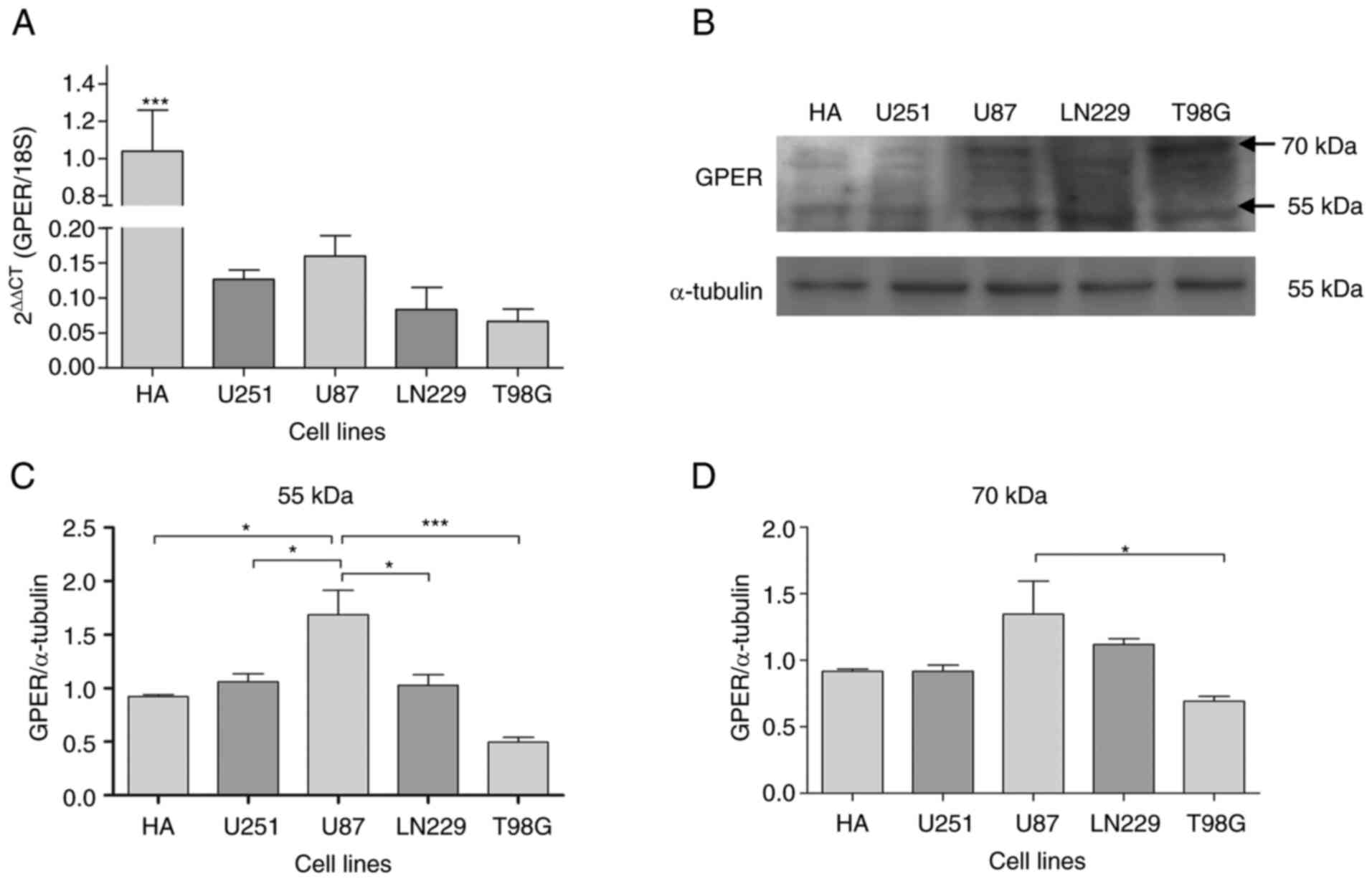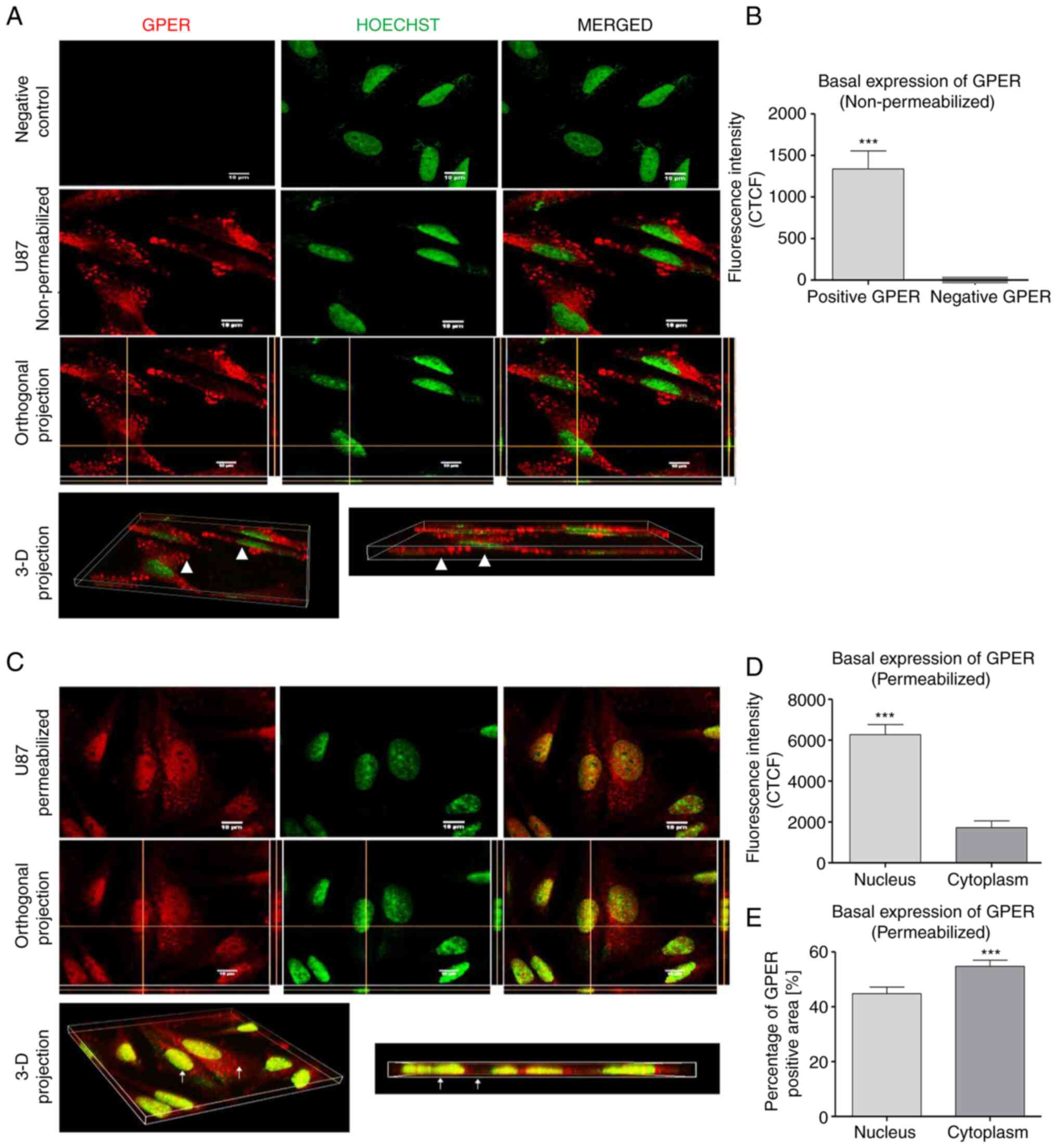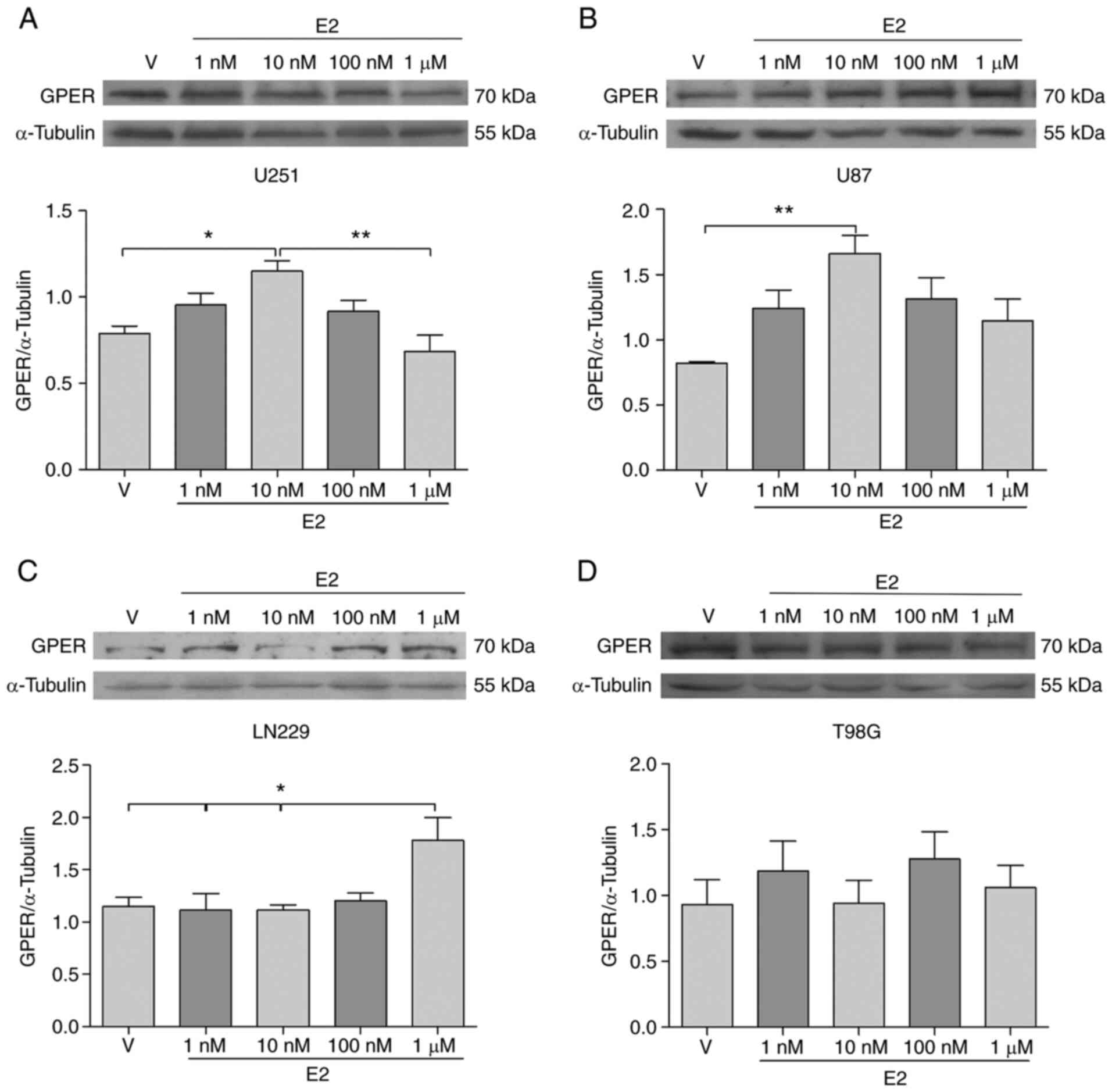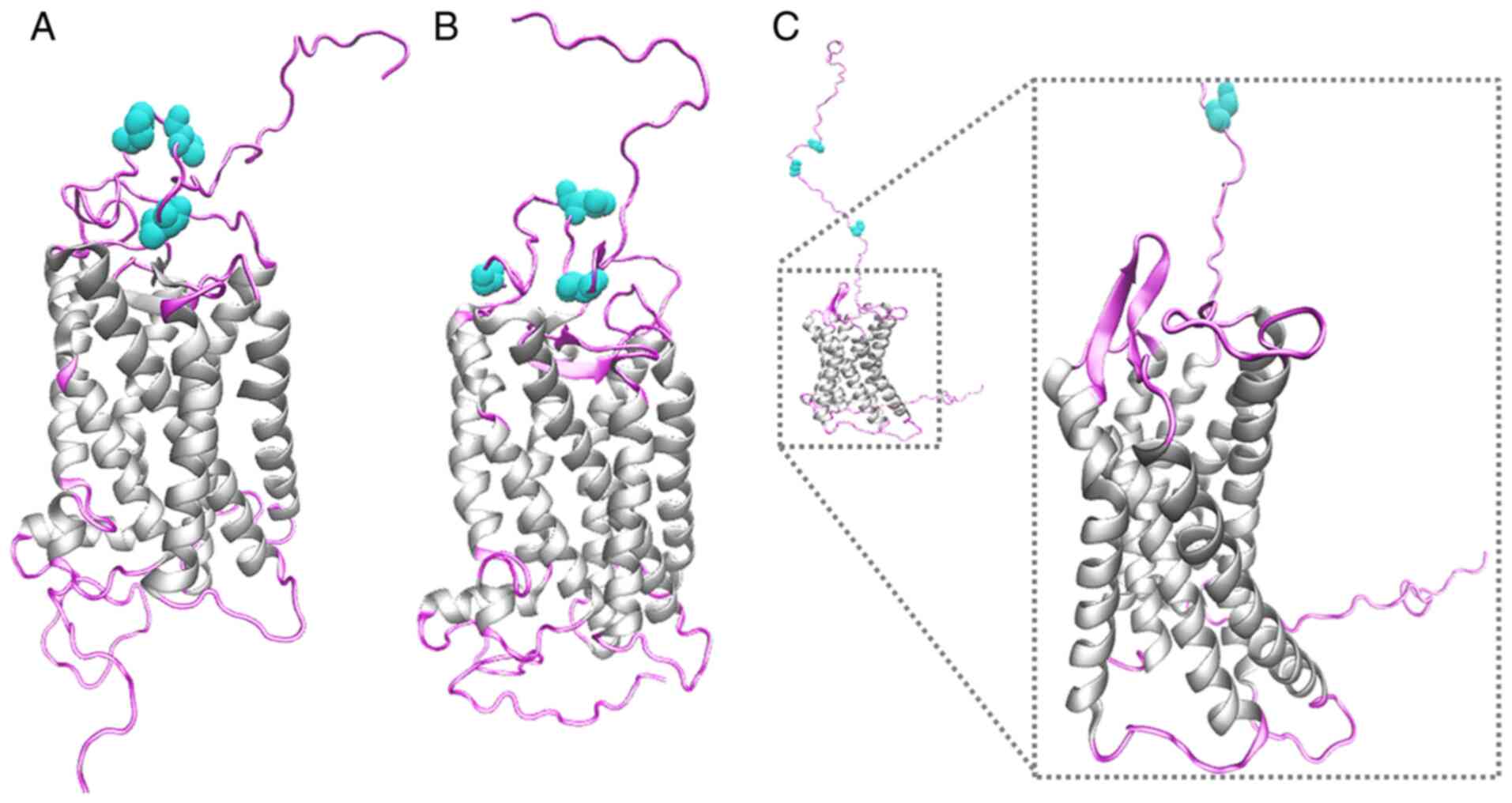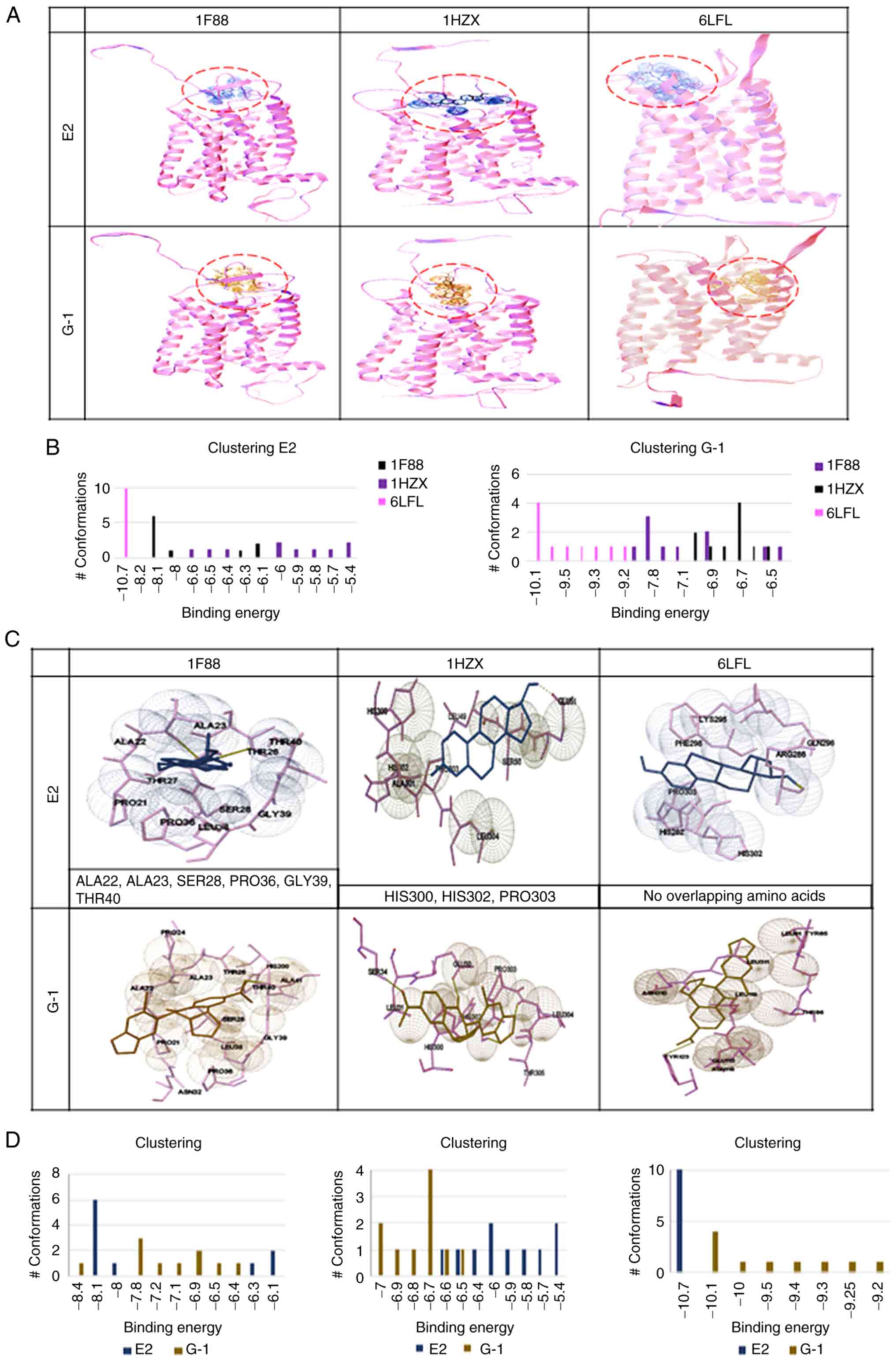|
1
|
Ostrom QT, Cioffi G, Gittleman H, Patil N,
Waite K, Kruchko C and Barnholtz-Sloan JS: CBTRUS statistical
report: Primary brain and other central nervous system tumors
diagnosed in the United States in 2012–2016. Neuro Oncol. 21 (Suppl
5):V1–V100. 2019. View Article : Google Scholar : PubMed/NCBI
|
|
2
|
Bello-Alvarez C and Camacho-Arroyo I:
Impact of sex in the prevalence and progression of glioblastomas:
The role of gonadal steroid hormones. Biol Sex Differ. 12:282021.
View Article : Google Scholar : PubMed/NCBI
|
|
3
|
González-Arenas A, Hansberg-Pastor V,
Hernández-Hernández OT, González-García TK, Henderson-Villalpando
J, Lemus-Hernández D, Cruz-Barrios A, Rivas-Suárez M and
Camacho-Arroyo I: Estradiol increases cell growth in human
astrocytoma cell lines through ERα activation and its interaction
with SRC-1 and SRC-3 coactivators. Biochim Biophys Acta.
1823:379–386. 2012. View Article : Google Scholar : PubMed/NCBI
|
|
4
|
Wan S, Jiang J, Zheng C, Wang N, Zhai X,
Fei X, Wu R and Jiang X: Estrogen nuclear receptors affect cell
migration by altering sublocalization of AQP2 in glioma cell lines.
Cell Death Discov. 4:492018. View Article : Google Scholar : PubMed/NCBI
|
|
5
|
Altiok N, Ersoz M and Koyuturk M:
Estradiol induces JNK-dependent apoptosis in glioblastoma cells.
Oncol Lett. 2:1281–1285. 2011. View Article : Google Scholar : PubMed/NCBI
|
|
6
|
Hernández-Vega AM, Del Moral-Morales A,
Zamora-Sánchez CJ, Piña-Medina AG, González-Arenas A and
Camacho-Arroyo I: Estradiol induces epithelial to mesenchymal
transition of human glioblastoma cells. Cells. 9:19302020.
View Article : Google Scholar : PubMed/NCBI
|
|
7
|
Sareddy GR, Nair BC, Gonugunta VK, Zhang
QG, Brenner A, Brann DW, Tekmal RR and Vadlamudi RK: Therapeutic
significance of estrogen receptor β agonists in gliomas. Mol Cancer
Ther. 11:1174–1182. 2012. View Article : Google Scholar : PubMed/NCBI
|
|
8
|
Owman C, Blay P, Nilsson C and Lolait SJ:
Cloning of human cDNA encoding a novel heptahelix receptor
expressed in Burkitt' s lymphoma and widely distributed in brain
and peripheral tissues. Biochem Biophys Res Commun. 228:285–292.
1996. View Article : Google Scholar : PubMed/NCBI
|
|
9
|
Revankar CM, Cimino DF, Sklar LA,
Arterburn JB and Prossnitz ER: A transmembrane intracellular
estrogen receptor mediates rapid cell signaling. Science.
307:1625–1630. 2005. View Article : Google Scholar : PubMed/NCBI
|
|
10
|
Yue J, Wang XS, Feng B, Hu LN, Yang LK, Lu
L, Zhang K, Wang YT and Liu SB: Activation of G - protein-coupled
receptor 30 protects neurons against excitotoxicity through
inhibiting excessive autophagy induced by glutamate. ACS. Chem
Neurosci. 10:4227–4236. 2019. View Article : Google Scholar : PubMed/NCBI
|
|
11
|
Yu T, Liu M, Luo H, Wu C, Tang X, Tang S,
Hu P, Yan Y, Wang Z and Tu G: GPER mediates enhanced cell viability
and motility via non-genomic signaling induced by 17β-estradiol in
triple-negative breast cancer cells. J Steroid Biochem Mol Biol.
143:392–403. 2014. View Article : Google Scholar : PubMed/NCBI
|
|
12
|
Liu Y, Ma H and Yao J: ERα, A key target
for cancer therapy: A review. Onco Targets Ther. 13:2183–2191.
2020. View Article : Google Scholar : PubMed/NCBI
|
|
13
|
Chen Y, Tang H, He J, Wu X, Wang L, Liu X
and Lin H: Interaction of nuclear ERs and GPER in vitellogenesis in
zebrafish. J Steroid Biochem Mol Biol. 189:10–18. 2019. View Article : Google Scholar : PubMed/NCBI
|
|
14
|
Sánchez DS, Fischer Sigel LK, Azurmendi
PJ, Vlachovsky SG, Oddo EM, Armando I, Ibarra FR and Silberstein C:
Estradiol stimulates cell proliferation via classic estrogen
receptor-alpha and G protein-coupled estrogen receptor-1 in human
renal tubular epithelial cell primary cultures. Biochem Biophys Res
Commun. 512:170–175. 2019. View Article : Google Scholar : PubMed/NCBI
|
|
15
|
Vivacqua A, Lappano R, De Marco P, Sisci
D, Aquila S, De Amicis F, Fuqua SA, Andò S and Maggiolini M: G
protein-coupled receptor 30 expression is upregulated by EGF and
TGF alpha in estrogen receptor alpha-positive cancer cells. Mol
Endocrinol. 23:1815–1826. 2009. View Article : Google Scholar : PubMed/NCBI
|
|
16
|
Smith HO, Arias-Pulido H, Kuo DY, Howard
T, Qualls CR, Lee SJ, Verschraegen CF, Hathaway HJ, Joste NE and
Prossnitz ER: GPR30 predicts poor survival for ovarian cancer.
Gynecol Oncol. 114:465–471. 2009. View Article : Google Scholar : PubMed/NCBI
|
|
17
|
Molina L, Figueroa CD, Bhoola KD and
Ehrenfeld P: GPER-1/GPR30 a novel estrogen receptor sited in the
cell membrane: Therapeutic coupling to breast cancer. Expert Opin
Ther Targets. 21:755–766. 2017. View Article : Google Scholar : PubMed/NCBI
|
|
18
|
Zhang KS, Chen HQ, Chen YS, Qiu KF, Zheng
XB, Li GC, Yang HD and Wen CJ: Bisphenol A stimulates human lung
cancer cell migration via upregulation of matrix metalloproteinases
by GPER/EGFR/ERK1/2 signal pathway. Biomed Pharmacother.
68:1037–1043. 2014. View Article : Google Scholar : PubMed/NCBI
|
|
19
|
Avino S, De Marco P, Cirillo F, Santolla
MF, De Francesco EM, Perri MG, Rigiracciolo D, Dolce V, Belfiore A,
Maggiolini M, et al: Stimulatory actions of IGF-I are mediated by
IGF-IR cross-talk with GPER and DDR1 in mesothelioma and lung
cancer cells. Oncotarget. 7:52710–52728. 2016. View Article : Google Scholar : PubMed/NCBI
|
|
20
|
Hirtz A, Lebourdais N, Rech F, Bailly Y,
Vaginay A, Smaïl-Tabbone M, Dubois-Pot-Schneider H and Dumond H:
GPER Agonist G-1 disrupts tubulin dynamics and potentiates
temozolomide to impair glioblastoma cell proliferation. Cells.
10:34382021. View Article : Google Scholar : PubMed/NCBI
|
|
21
|
Deng J, Wang W, Yu G and Ma X:
MicroRNA-195 inhibits epithelial-mesenchymal transition by
targeting G protein-coupled estrogen receptor 1 in endometrial
carcinoma. Mol Med Rep. 20:4023–4032. 2019.PubMed/NCBI
|
|
22
|
Pfaffl MW: A new mathematical model for
relative quantification in real-time RT-PCR. Nucleic Acids Res.
29:e452001. View Article : Google Scholar : PubMed/NCBI
|
|
23
|
Schmittgen TD and Livak KJ: Analyzing
real-time PCR data by the comparative C(T) method. Nat Protoc.
3:1101–1108. 2008. View Article : Google Scholar : PubMed/NCBI
|
|
24
|
Measuring cell fluorescence using ImageJ,
. https://theolb.readthedocs.io/en/latest/imaging/measuring-cell-fluorescence-using-imagej.htmlSeptember
20–2021
|
|
25
|
Khan A, Fornes O, Stigliani A, Gheorghe M,
Castro-Mondragon JA, Van Der Lee R, Bessy A, Chèneby J, Kulkarni
SR, Tan G, et al: JASPAR 2018: Update of the open-access database
of transcription factor binding profiles and its web framework.
Nucleic Acids Res. 46(D1):D260–D266. 2018. View Article : Google Scholar : PubMed/NCBI
|
|
26
|
Heinz S, Benner C, Spann N, Bertolino E,
Lin YC, Laslo P, Cheng JX, Murre C, Singh H and Glass CK: Simple
combinations of lineage-determining transcription factors prime
cis-regulatory elements required for macrophage and B cell
identities. Mol Cell. 38:576–589. 2010. View Article : Google Scholar : PubMed/NCBI
|
|
27
|
Kulakovskiy IV, Vorontsov IE, Yevshin IS,
Sharipov RN, Fedorova AD, Rumynskiy EI, Medvedeva YA, Magana-Mora
A, Bajic VB, Papatsenko DA, et al: HOCOMOCO: Towards a complete
collection of transcription factor binding models for human and
mouse via large-scale ChIP-Seq analysis. Nucleic Acids Res.
46(D1):D252–D259. 2018. View Article : Google Scholar : PubMed/NCBI
|
|
28
|
Tan G and Lenhard B: TFBSTools: An
R/bioconductor package for transcription factor binding site
analysis. Bioinformatics. 32:1555–1556. 2016. View Article : Google Scholar : PubMed/NCBI
|
|
29
|
Thorvaldsdóttir H, Robinson JT and Mesirov
JP: Integrative genomics viewer (IGV): High-performance genomics
data visualization and exploration. Brief Bioinform. 14:178–192.
2013. View Article : Google Scholar : PubMed/NCBI
|
|
30
|
Pettersen EF, Goddard TD, Huang CC, Couch
GS, Greenblatt DM, Meng EC and Ferrin TE: UCSF Chimera-A
visualization system for exploratory research and analysis. J
Comput Chem. 25:1605–1612. 2004. View Article : Google Scholar : PubMed/NCBI
|
|
31
|
Webb B and Sali A: Comparative protein
structure modeling using MODELLER. Curr Protoc Bioinformatics.
54:5.6.1–5.6.37. 2017.PubMed/NCBI
|
|
32
|
Sánchez R and Šali A: Comparative Protein
Structure Modeling in Genomics. Methods in Molecular Biology.
Sánchez R and Sali A: Vol. 143. Humana Press Inc.; Totowa, NJ: pp.
97–127. 1999, PubMed/NCBI
|
|
33
|
Finn RD, Clements J and Eddy SR: HMMER web
server: Interactive sequence similarity searching. Nucleic Acids
Res. 39((Web Server Issue)): W29–W37. 2011. View Article : Google Scholar : PubMed/NCBI
|
|
34
|
Wiederstein M and Sippl MJ: ProSA-web:
Interactive web service for the recognition of errors in
three-dimensional structures of proteins. Nucleic Acids Res.
35((Web Server Issue)): W407–W410. 2007. View Article : Google Scholar : PubMed/NCBI
|
|
35
|
Humphrey W, Dalke A and Schulten K: VMD:
Visual molecular dynamics. J Mol Graph. 14:33–8. 27–8. 1996.
View Article : Google Scholar : PubMed/NCBI
|
|
36
|
Goodsell DS, Sanner MF, Olson AJ and Forli
S: The AutoDock suite at 30. Protein Sci. 30:31–43. 2021.
View Article : Google Scholar : PubMed/NCBI
|
|
37
|
O'Boyle NM, Banck M, James CA, Morley C,
Vandermeersch T and Hutchison GR: Open Babel: An open chemical
toolbox. J Cheminform. 3:332011. View Article : Google Scholar : PubMed/NCBI
|
|
38
|
Bitencourt-Ferreira G, Pintro VO and de
Azevedo WF Jr: Docking with AutoDock4. Methods Mol Biol.
2053:125–148. 2019. View Article : Google Scholar : PubMed/NCBI
|
|
39
|
Azizian H, Khaksari M, Asadi karam G,
Esmailidehaj M and Farhadi Z: Cardioprotective and
anti-inflammatory effects of G-protein coupled receptor 30 (GPR30)
on postmenopausal type 2 diabetic rats. Biomed Pharmacother.
108:153–164. 2018. View Article : Google Scholar : PubMed/NCBI
|
|
40
|
Pupo M, Bodmer A, Berto M, Maggiolini M,
Dietrich PY and Picard D: A genetic polymorphism repurposes the
G-protein coupled and membrane-associated estrogen receptor GPER to
a transcription factor-like molecule promoting paracrine signaling
between stroma and breast carcinoma cells. Oncotarget.
8:46728–46744. 2017. View Article : Google Scholar : PubMed/NCBI
|
|
41
|
Gonzalez de Valdivia E, Sandén C, Kahn R,
Olde B and Leeb-Lundberg LMF: Human G protein-coupled receptor 30
is N-glycosylated and N-terminal domain asparagine 44 is required
for receptor structure and activity. Biosci Rep.
39:BSR201824362019. View Article : Google Scholar : PubMed/NCBI
|
|
42
|
Buruiană A, Florian ȘI, Florian AI, Timiș
TL, Mihu CM, Miclăuș M, Oșan S, Hrapșa I, Cataniciu RC, Farcaș M
and Șușman S: The roles of miRNA in glioblastoma tumor cell
communication: Diplomatic and aggressive negotiations. Int J Mol
Sci. 21:19502020. View Article : Google Scholar : PubMed/NCBI
|
|
43
|
Robertson FL, Marqués-Torrejón MA,
Morrison GM and Pollard SM: Experimental models and tools to tackle
glioblastoma. Dis Model Mech. 12:dmm0403862019. View Article : Google Scholar : PubMed/NCBI
|
|
44
|
Brennan CW, Verhaak RG, McKenna A, Campos
B, Noushmehr H, Salama SR, Zheng S, Chakravarty D, Sanborn JZ,
Berman SH, et al: The somatic genomic landscape of glioblastoma.
Cell. 155:462–477. 2013. View Article : Google Scholar : PubMed/NCBI
|
|
45
|
Yan Y, Liu H, Wen H, Jiang X, Cao X, Zhang
G and Liu G: The novel estrogen receptor GPER regulates the
migration and invasion of ovarian cancer cells. Mol Cell Biochem.
378:1–7. 2013. View Article : Google Scholar : PubMed/NCBI
|
|
46
|
Gonzalez de Valdivia E, Broselid S, Kahn R
and Leeb-lundberg LMF: G protein-coupled estrogen receptor 1
(GPER1)/GPR30 increases ERK1/2 activity through PDZ motif-dependent
and -independent mechanisms. J Biol Chem. 292:9932–9943. 2017.
View Article : Google Scholar : PubMed/NCBI
|
|
47
|
Samartzis EP, Noske A, Meisel A, Varga Z,
Fink D and Imesch P: The G protein-coupled estrogen receptor (GPER)
is expressed in two different subcellular localizations reflecting
distinct tumor properties in breast cancer. PLoS One. 9:e832962014.
View Article : Google Scholar : PubMed/NCBI
|
|
48
|
Sjöström M, Hartman L, Grabau D, Fornander
T, Malmström P, Nordenskjöld B, Sgroi DC, Skoog L, Stål O,
Leeb-Lundberg LM and Fernö M: Lack of G protein-coupled estrogen
receptor (GPER) in the plasma membrane is associated with excellent
long-term prognosis in breast cancer. Breast Cancer Res Treat.
145:61–71. 2014. View Article : Google Scholar : PubMed/NCBI
|
|
49
|
Madeo A and Maggiolini M: Nuclear
alternate estrogen receptor Gpr30 mediates 17beta-estradiol-induced
gene expression and migration in breast cancer-associated
fibroblasts. Cancer Res. 70:6036–6046. 2010. View Article : Google Scholar : PubMed/NCBI
|
|
50
|
Pupo M, Vivacqua A, Perrotta I, Pisano A,
Aquila S, Abonante S, Gasperi-Campani A, Pezzi V and Maggiolini M:
The nuclear localization signal is required for nuclear GPER
translocation and function in breast cancer-associated fibroblasts
(CAFs). Mol Cell Endocrinol. 376:23–32. 2013. View Article : Google Scholar : PubMed/NCBI
|
|
51
|
Cheng SB, Quinn JA, Graeber CT and Filardo
EJ: Down-modulation of the G-protein-coupled estrogen receptor,
GPER, from the cell surface occurs via a trans-Golgi-proteasome
pathway. J Biol Chem. 286:22441–22455. 2011. View Article : Google Scholar : PubMed/NCBI
|
|
52
|
Figueira MI, Cardoso HJ and Socorro S: The
role of GPER signaling in carcinogenesis: A focus on prostate
cancer. Recent Trends in Cancer Biology: Spotlight on Signaling
Cascades and microRNAs. Fayyaz S and Farooqi A: Springer; Cham: pp.
59–117. 2018
|
|
53
|
Innamorati G, Le Gouill C, Balamotis M and
Birnbaumer M: The long and the short cycle. Alternative
intracellular routes for trafficking of G-protein-coupled
receptors. J Biol Chem. 276:13096–13103. 2001. View Article : Google Scholar : PubMed/NCBI
|
|
54
|
Zhu CX, Xiong W, Wang ML, Yang J, Shi HJ,
Chen HQ and Niu G: Nuclear G protein-coupled oestrogen receptor
(GPR30) predicts poor survival in patients with ovarian cancer. J
Int Med Res. 46:723–731. 2018. View Article : Google Scholar : PubMed/NCBI
|
|
55
|
Plante BJ, Lessey BA, Taylor RN, Wang W,
Bagchi MK, Yuan L, Scotchie J, Fritz MA and Young SL: G
protein-coupled estrogen receptor (GPER) expression in normal and
abnormal endometrium. Reprod Sci. 19:684–693. 2012. View Article : Google Scholar : PubMed/NCBI
|
|
56
|
Fan DX, Yang XH, Li YN and Guo L:
17β-estradiol on the expression of G-Protein coupled estrogen
receptor (GPER/GPR30) mitophagy, and the PI3K/Akt signaling pathway
in ATDC5 chondrocytes in vitro. Med Sci Monit. 24:1936–1947. 2018.
View Article : Google Scholar : PubMed/NCBI
|
|
57
|
Gilligan LC, Rahman HP, Hewitt AM, Sitch
AJ, Gondal A, Arvaniti A, Taylor AE, Read ML, Morton DG and Foster
PA: Estrogen activation by steroid sulfatase increases colorectal
cancer proliferation via GPER. J Clin Endocrinol Metab.
102:4435–4447. 2017. View Article : Google Scholar : PubMed/NCBI
|
|
58
|
Huang R, Li J, Pan F, Zhang B and Yao Y:
The activation of GPER inhibits cells proliferation, invasion and
EMT of triple-negative breast cancer via CD151/miR-199a-3p
bio-axis. Am J Transl Res. 12:32–44. 2020.PubMed/NCBI
|
|
59
|
Prossnitz ER and Arterburn JB:
International union of basic and clinical pharmacology. XCVII. G
protein-coupled estrogen receptor and its pharmacologic modulators.
Pharmacol Rev. 67:505–540. 2015. View Article : Google Scholar : PubMed/NCBI
|
|
60
|
Luo J and Liu D: Does GPER really function
as a G protein-coupled estrogen receptor in vivo? Front Endocrinol
(Lausanne). 11:1482020. View Article : Google Scholar : PubMed/NCBI
|
|
61
|
Jala VR, Radde BN, Haribabu B and Klinge
C: Enhanced expression of G-protein coupled estrogen receptor
(GPER/GPR30) in lung cancer. BMC Cancer. 12:6242012. View Article : Google Scholar : PubMed/NCBI
|
|
62
|
Milligan G, Canals M, Pediani JD, Ellis J
and Lopez-Gimenez JF: The role of GPCR Dimerisation/Oligomerisation
in receptor signalling. Ernst Schering Found Symp Proc. 2:145–161.
2006.PubMed/NCBI
|
|
63
|
Gurevich VV and Gurevich EV: How and why
do GPCRs dimerize? Trends Pharmacol Sci. 29:234–240. 2008.
View Article : Google Scholar : PubMed/NCBI
|
|
64
|
Grande F, Occhiuzzi MA, Lappano R, Cirillo
F, Guzzi R, Garofalo A, Jacquot Y, Maggiolini M and Rizzuti B:
Computational approaches for the discovery of GPER targeting
compounds. Front Endocrinol (Lausanne). 11:5172020. View Article : Google Scholar : PubMed/NCBI
|
|
65
|
Méndez-Luna D, Martínez-Archundia M,
Maroun RC, Ceballos-Reyes G, Fragoso-Vázquez MJ, González-Juárez DE
and Correa-Basurto J: Deciphering the GPER/GPR30-agonist and
antagonists interactions using molecular modeling studies,
molecular dynamics, and docking simulations. J Biomol Struct Dyn.
33:2161–2172. 2015. View Article : Google Scholar : PubMed/NCBI
|















